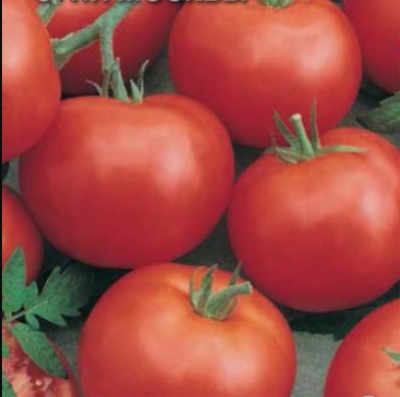
- Authors: Zhidkova V.A., Mikhed V.S., Altukhov Yu.P., Arkhipova T.P.
- Year of approval: 2000
- Category: grade
- Growth type: determinant
- Appointment: fresh consumption, for whole-fruit preservation, for ketchup and tomato paste
- Ripening period: early
- Ripening time, days: 92-107
- Growing conditions: for open ground
- Marketable fruit yield,%: 78%
- Bush size: undersized
If you want to grow early tomatoes on the site, which are unpretentious in care, bear fruit stably and abundantly, without taking up much space, then you should pay attention to the Ogni Moskvy variety.
Breeding history
An early ripe tomato Ogni of Moscow was created by a group of Russian breeders (Arkhipova, Altukhov, Zhidkova and Mikhed) in 1999. The variety joined the ranks of the State Register of Breeding Achievements of the Russian Federation in 2000. Recommended for growing in all regions of Russia. The nightshade crop grows well in open ground conditions.
Description of the variety
Tomato Ogni Moskvy is a low-growing determinant plant, reaching a height of 45 cm. The semi-sprawling bush has an average thickening with large dark green leaves, moderate branching, a strong central stem, a developed root system and intermediate inflorescences. The first fruit cluster grows above 6-7 leaves, 3-5 berries are tied in it. During cultivation, a garter to a support and partial pinching may be necessary, which will improve the quantity and quality of fruits on the bushes.
A peculiarity of the species is that the tomato has a universal purpose, therefore it is very tasty fresh, salted, processed, in the form of blanks. Especially tasty tomato for whole fruit canning.
The main qualities of the fruit
Medium-fruit vegetable Moscow Lights is characterized by medium size - 103-105 grams and a regular rounded shape without the slightest ribbing on the surface. At the stage of maturity, the tomato is evenly covered with a rich red color, and when unripe, the vegetable is pale green in color with a dark speck at the base. The tomato has a dense skin, so it is not afraid of cracking, transportation and long-term keeping. Perfectly regular shape and gloss of the peel make the tomato marketable.
Taste characteristics
Tomatoes are endowed with excellent taste - the fruit is sweet and sour, there is a pronounced spicy aroma. The tomato pulp is dense and fleshy. It is noteworthy that the vegetable has good juiciness and a small amount of seeds.
Ripening and fruiting
The variety "Lights of Moscow" is early maturing. It takes a little more than 3 months (102-107 days) from germination of shoots to ripening of fruits. The fruits ripen gradually, so it is not always possible to collect them with whole fruit clusters. The active phase of fruiting of the nightshade crop falls on the period from mid-July to the second half of August.
Yield
Tomato yield indicators are consistently high. Subject to agrotechnical recommendations, up to 3.6-5.2 kg of ripe berries can be removed from bushes growing on 1 m2.
The timing of planting seedlings and planting in the ground
The plant is planted in a classic seedling way. The seed is necessarily disinfected, and the soil is pre-disinfected. If necessary, the seeds are sorted.Sowing seeds falls on March 20-30 (55-60 days before transplanting to the garden). The best environment for the growth of bushes is a room temperature of + 22 ... 27, sufficient humidity and good lighting. The seedlings will germinate in 3-5 days. After the appearance of 2-3 leaves on the bush, a dive is carried out. In addition, plants can be hardened 7-10 days before transplanting. This is what contributes to the early adaptation of seedlings to new conditions.
The planting of bushes on the beds is carried out from 10 to 20 May, when the threat of night temperature drops is behind, and the temperature in the air has stabilized.

Growing tomato seedlings is an extremely important process, because it largely depends on whether the gardener can harvest at all. All aspects must be taken into account, from seedbed preparation to planting in the ground.
Landing scheme
Planting density and pattern is just as important as adhering to all other grooming features. Due to the fact that tomato bushes are quite compact, up to 4-6 plants can be planted per 1 m2. Ideal for planting tomatoes is a 70x60 cm scheme.

Growing and caring
The plot for tomato seedlings should be weed-free, dug up, well-ventilated, loose, and also moderately moist and fertile. The best place will be a place where the sun's rays penetrate well. Most often, Moscow Lights tomatoes are planted on loamy soils.
Caring for this variety is standard: watering with warm water, loosening the soil, adding mineral components, tying bushes, partial pinching (once a week) and removing the lower leaves, as well as preventing viruses and protecting against invasions of harmful insects.




A plant needs different micronutrients at each stage of growth. All fertilizers can be divided into two groups: mineral and organic. Folk remedies are often used: iodine, yeast, bird droppings, eggshells.
It is important to observe the rate and period of feeding. This also applies to folk remedies and organic fertilizers.
Disease and pest resistance
The plant has high immunity, so tomato diseases are not terrible for tomatoes. An exception is viruses that are prevented by spraying.


Resistant to adverse weather conditions
The variety has a high resistance to stress, so it is not afraid of droughts, sudden temperature fluctuations and heat. Excessive moisture and drafts can negatively affect the culture.

























































































